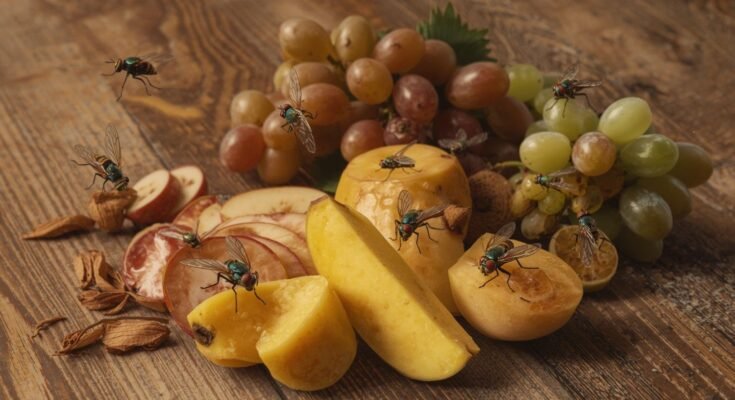Introduction
Every year, when summer turns to fall, I notice how fruit flies get more active around my home. They are small, pesky, and truly annoying, especially when the abundance of fresh garden produce is left on the counter. I once even wrote in my own blog about how frustrating it felt to deal with them, but over time, I learned to trust some simple tips. Saying ugh at the sight of these critters buzzing in the kitchen doesn’t solve much. They’re linked to a quick life cycle, which means they multiply fast. Without effort to reduce their breeding grounds, they can become grosser than any other bugs in the house. That’s why finding the right method to eliminate them is crucial.
Practical Ways to Keep Them Away
From my own experience, preventing a fruit fly infestation is much easier than curing one. I always show friends a few natural and DIY ways that really work. For example, I once used vinegar traps, and in just a few simple steps, I could create a fruit fly-free zone in my kitchen. You can share these tricks with others, too, as they help prevent those little bugs from becoming too prolific. With patience, I’ve found that you can rid your space of these pests and keep your place comfortable without much hassle.
The Life Cycle of Fruit Flies
I once left a cut apple on the counter, and within minutes, it attracted fruit flies eager to feed. These tiny, winged insects measure only a few mm long, with a front that looks brown, a back that appears black, and reddish eyes that are easy to spot. They reproduce rapidly for two main reasons: their life cycle is short, moving from egg to mature adult in just a few days, and they can lay hundreds of microscopic eggs at a time. I’ve seen how they are fond of starchy, sweet fruits and vegetables like tomatoes, squash, bananas, potatoes, and onions, especially when these are stored unrefrigerated and become ripe or rotting in the open.
Common Places They Breed
Over the years, I’ve noticed layers of waste where they thrive—in water drains, garbage bins, garbage disposals, even mops, moist rags, and other organic substances. They sneak indoors by catching a hitch or ride on produce, or they simply slip into the kitchen through doors, squeeze into cracks, or find gaps in window screens and seals. Once inside, it doesn’t take long before they multiply, which is why knowing their habits makes it easier to break the cycle and stop them from spreading.
How Dangerous are Fruit Flies?
Many people think fruit flies are just harmless kitchen pests, but from my own experience, they can actually carry detrimental bacteria and even pathogenic organisms that may contaminate food. I once left uncovered leftovers on the counter, and within hours, these pests were all over it. That moment taught me to always prevent their proliferation by acting quickly and choosing the right methods to get rid of them before they spread.
One habit I strongly employ is to wash all containers, dishes, and utensils in hot, soapy water. If possible, I run them through a dishwasher, which uses hotter water than we can tolerate by hand. It does an excellent cleaning job and ensures no hidden eggs or bacteria remain. With simple steps like this, I’ve kept my kitchen much safer and more enjoyable to cook in.
DIY Fruit Fly Traps
I still remember how annoying it felt when fruit flies filled my kitchen one summer evening. Instead of running to the store, I looked for a quick DIY fix to get rid of them. That’s when I discovered how easy traps can be made with things I already had at home, and it worked surprisingly well.
Now, whenever these pests show up, I set up simple DIY traps with vinegar, soap, or even a piece of fruit in a cup. It doesn’t take long before the flies are gone, and my kitchen feels comfortable again. Using these easy tricks, I’ve learned that staying prepared is the smartest way to keep your space free from these annoying intruders.
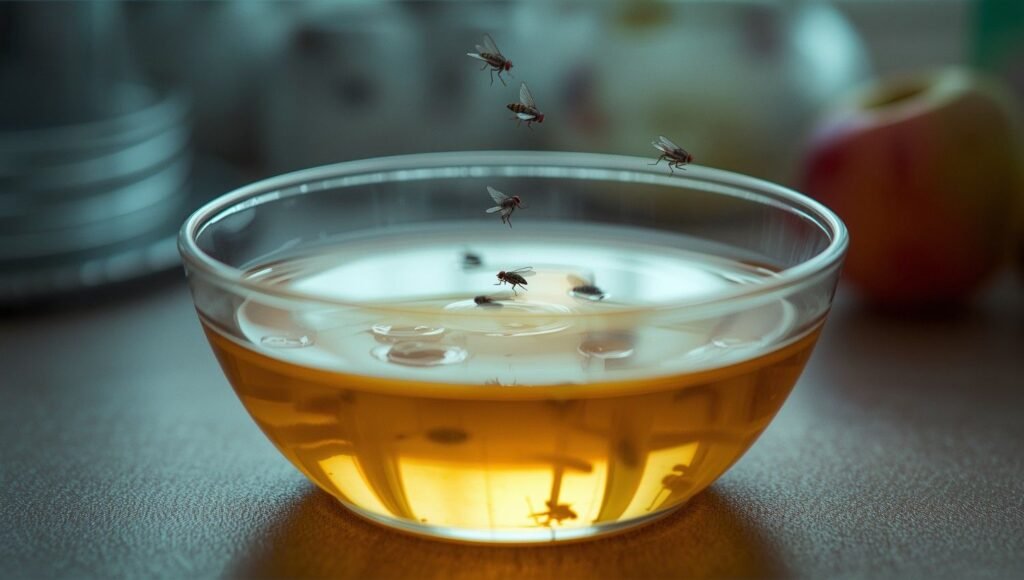
Fruit Fly Trap – Bowl Method
When I wanted a quick fix, I grabbed a small bowl or even a cup and added a little liquid to start. My go-to mix is apple cider vinegar with a few drops of dish soap and a squirt of water. Once you fill the container, it becomes an easy trap that works almost instantly.
I usually set the bowl in an area where fruit flies are most present, because the strong scent of vinegar keeps them attracted. As soon as they land, the soapy solution makes sure they can’t escape. By placing it in the right place, I’ve managed to clear my kitchen of these pests with very little effort.
DIY Fruit Fly Apple Cider Vinegar Trap: Jar Method
When I wanted to rid my kitchen of fruit flies, I tried a method that felt like an exciting experiment. It’s a smart variation of the classic vinegar trap, and it’s surprisingly effective with only a few simple ingredients. I use apple cider vinegar in a glass jar or even a bowl, then add a few drops of dish soap. The soap helps break the surface tension, so once the flies are attracted and enter, they quickly become trapped.
To finish the setup, I cover the container with plastic wrap, make sure it’s tight with a rubber band or elastic, and then use a toothpick to poke small holes. This way, the pests find their way inside but can’t escape. I always make sure it’s secure, and every time I try it, I’m impressed at how many flies end up caught. It’s a simple, reliable way to handle the problem without much fuss.
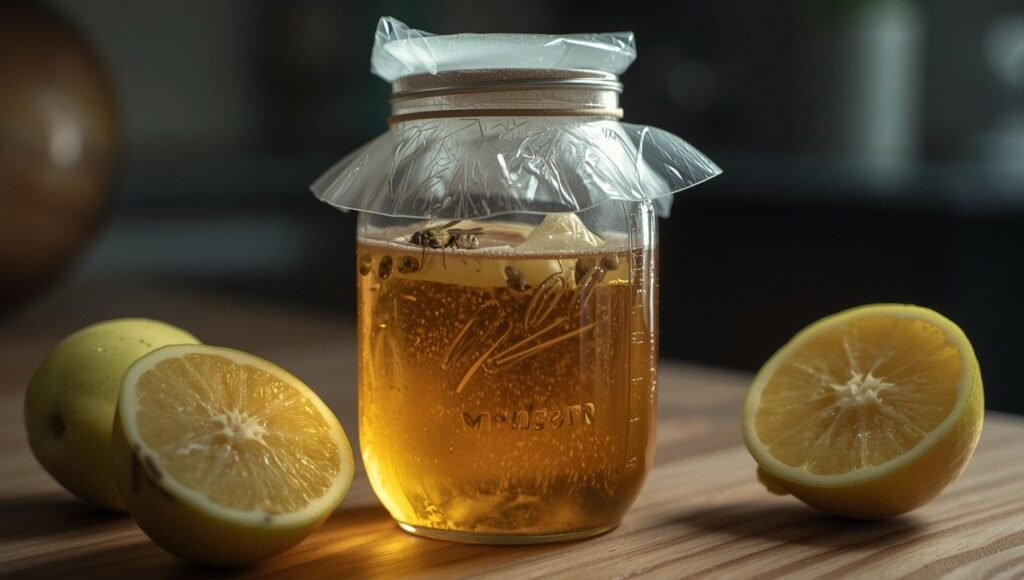
Other Fruit Fly Trap Methods To Try
When vinegar traps aren’t at hand, I’ve found other methods that can still help me get rid of fruit flies quickly. In my own kitchen, I once used a piece of overripe fruit in a cup covered with plastic wrap, and the flies swarmed inside within hours. It worked just as well as vinegar, proving there’s more than one way to handle these pests.
Sometimes I rotate between different methods so the flies don’t keep returning to the same setup. Whether it’s a bit of wine, juice, or even a DIY container with soapy water, these tricks have all saved me at one time or another. The key is acting fast to keep your kitchen comfortable and your food safe, because nothing ruins a cooking space faster than buzzing pests.
Fruit Method
I once discovered that an overripe banana or peach could work as a natural trap for flies. Placing a piece of fruit in a bowl or jar, I would cover the top with plastic wrap and poke small holes. The pests were quickly attracted to the sweet, rotting smell and entered without hesitation.
Within hours, several flies became trapped inside, unable to escape. I’ve repeated this trick many times, and it’s one of the easiest ways to handle them without effort. All it takes is a bit of spoiled fruit, a quick setup, and patience, and soon enough, the problem is contained.
Wine Method
One trick I’ve used is the wine trap, which works better than you might expect. I usually pour a small amount into a jar or glass, leaving about an inch at the bottom. Then I place plastic wrap over the opening, cover it tightly with a rubber band, and poke a few small holes. The smell is strong enough that fruit flies are quickly attracted and fly straight inside.
Within hours, the pests are trapped, and I can see those little buggers floating in the liquid. I’ve learned to always secure the setup properly so they can’t escape. It’s a simple solution that takes only a few minutes and makes the kitchen feel more comfortable again.
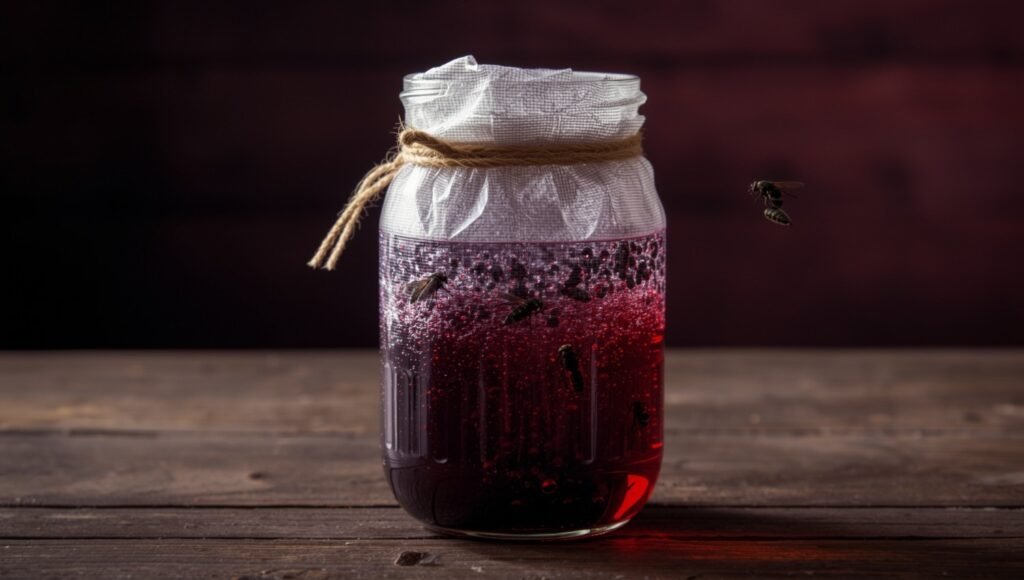
Prevent Fruit Flies Before They Start
From my own experience, preventing a fruit fly infestation is far easier than dealing with one after it has already begun. I once ignored a bowl of ripe fruit on the counter, and within days, my kitchen was buzzing with pests. That’s when I realized how essential it is to follow simple tips early on.
Now I always keep my counters clean, store food properly, and pay attention to little habits that make a big difference. These steps create a fly-free space where I can cook and relax without worry. By building this routine into my daily life, I’ve been able to stop the problem before it even starts.
Keep Your Kitchen Clean
From what I’ve seen, a clean kitchen is the strongest enemy of the fruit fly. Even the smallest spills or crumbs can quickly become breeding grounds if ignored. After each meal, I make it a habit to wipe counters, countertops, stoves, and dining tables so no food residue is left behind. I also keep dishes clean by washing them promptly, because leaving dirty plates in the sink only adds more particles that attract pests.
Another habit that makes a big difference is learning to take out the trash regularly. I make sure the cans are empty, use bags with tight closures, and keep odors in check to prevent smells that can lure flies indoors. By paying attention to these details, the kitchen stays fresh and less inviting to pests of any kind.
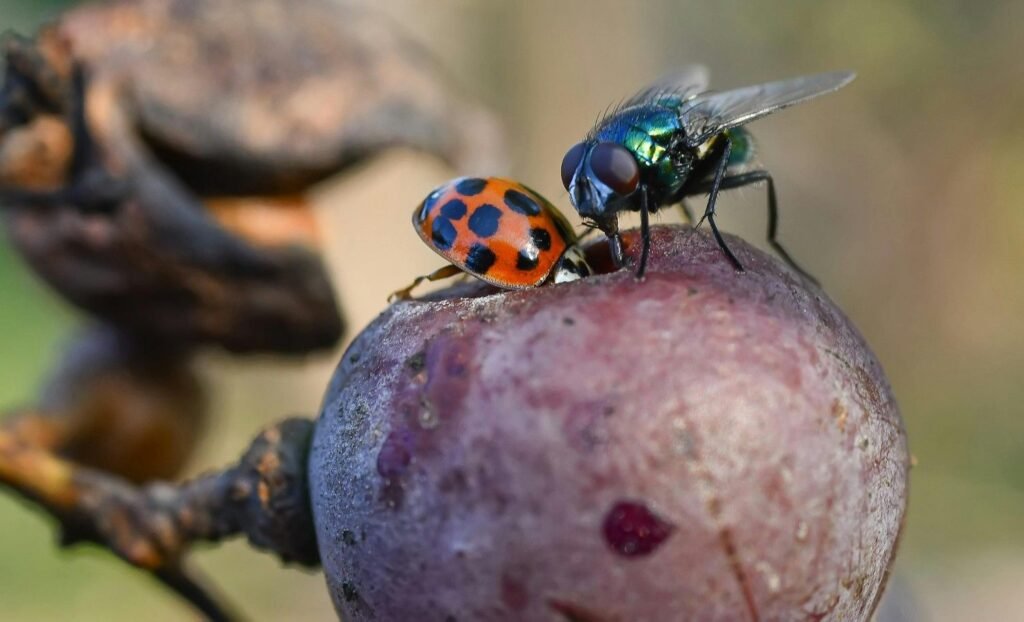
Proper Food Storage
One of the best habits I’ve built is storing food carefully to reduce the chances of a fruit fly infestation. I always refrigerate ripe fruits and vegetables, since the ripening process makes them more attractive to pests. Using airtight containers that are well sealed helps prevent flies from accessing my food. I also make sure to inspect produce regularly for signs of spoilage so I can discard anything past its prime before it becomes a problem.
Another simple trick is to wash what I store after bringing it home from the market, since hidden eggs may already be on the surface. I’m extra careful with berries because they tend to mold faster when wet. These small adjustments are powerful prevention tips that create an environment less appealing to fruit flies and make my kitchen easier to manage.
How to Prevent Fruit Flies?
I’ve found that reducing fruit fly breeding sites is often the best step in preventing a bigger problem. Instead of waiting for a cure, the smarter strategy is to contain their populations early. To get rid of them, I focus on removing the sources that attract pests and eliminating their favorite locations. I always store fruits and vegetables properly, especially those with damaged skin or unused portions, by placing them in the refrigerator.
Keeping things clean makes a big difference, too. I wipe up spills, mop away liquids and water under cupboards or fridges, and treat them as prime estate for fly advancement. I also rinse out juice and milk containers before recycling, clear recycle bins regularly, and check for any signs of growth. Even my trash cans get a good wipe with warm, soapy water during the gardening season, at least monthly. These small routines keep flies away and make my home much more comfortable.
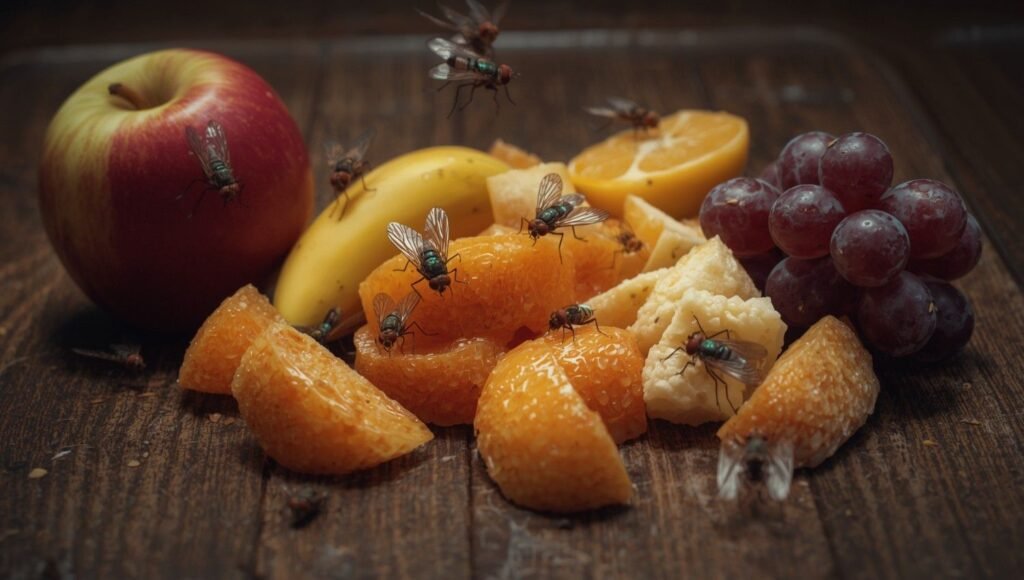
How to Eliminate Fruit Flies with a Fruit Fly Trap?
When I first struggled with a growing fruit fly population, I wanted a solution that was both simple and effective. That’s when I tried using a trap that was completely chemical-free, and it worked better than expected. With just a few household items, I was able to take back control and stop the pests from flourishing in my kitchen.
The best part is that the setup is straightforward and totally uncomplicated. I remember showing a friend how quickly it worked, and they were surprised at how easy it was. Once the trap was in place, the problem began to shrink within hours, proving that you don’t need harsh solutions to handle such a big issue.
Pour a Little Apple Cider Vinegar into a Mason Jar or a Cup
One of the easiest tricks I’ve used is to pour a few cm of apple cider vinegar into a glass vessel or container. The sweetness instantly attracted nearby fruit flies, pulling them in faster than I expected. It’s such a quick setup that I’ve made it a regular part of my routine whenever I notice them around.
What I like most about this method is how simple it is to monitor and check my progress. By glancing at the container, I can see how many flies have been caught and know when to refresh the mixture. It’s an effortless way to keep control over the problem and prevent things from getting out of hand.
Add a Drop or Two of Liquid Dish Soap & Swirl It Around a Bit to Reduce the Surface Tension
I’ve found that adding just a little dish soap to vinegar traps really works in the best possible way. Without it, the flies often land on top and escape, but with soap mixed in, they sink quickly and get trapped.
Over time, this simple adjustment has saved me the frustration of watching flies buzz around the rim. It’s such an easy trick that I always use it whenever I prepare a trap, because it works every way I’ve tried it.
Make a Wide-Mouth Paper Cone and Place It in the Jar
I once tried an alternative method where I made a paper cone and placed it in a container filled with apple cider vinegar. The fruit flies were quickly attracted by the sweetness and flew inside, but they couldn’t escape and eventually drowned. This simple design worked just as well as using plastic wrap with holes. Adding a drop of dish soap can also make the trap more effective.
I remember being surprised at how many flies I caught within hours. The buzzing in my kitchen stopped, and I realized how easy it was to rid my space of such a nuisance. By using basic ingredients, a toothpick to poke tiny holes when needed, and making sure to cover the jar for proper sealing, this method gave excellent results without much effort.

